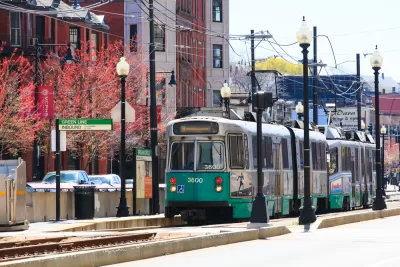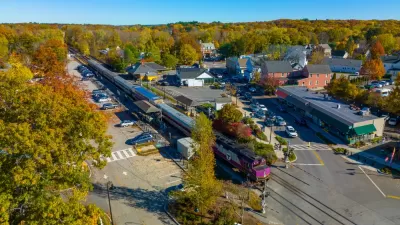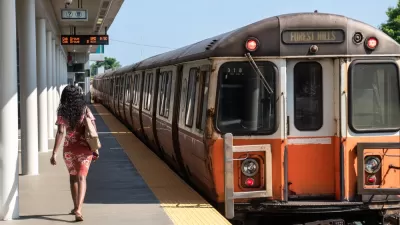Communities near transit stations will have to comply with a new set of regulations that support multifamily development and increased housing density.

Half of all Massachusetts towns will have to comply with a newly released set of rules governing multifamily zoning in areas near transit stations, reports Colin A. Young for the Lowell Sun.
Known as ‘MBTA communities,’ after the Massachusetts Bay Transportation Authority, 175 cities and towns are now required to meet certain conditions to continue receiving state funding from several major sources. “The multifamily housing districts must have a minimum gross density of 15 units per acre; be no more than half a mile from a commuter rail station, subway station, ferry terminal or bus station; have no age restrictions; and be suitable for families with children.”
In a letter, Secretary of the Executive Office of Housing and Economic Development (EOHED) Mike Kennealy and Undersecretary Jennifer Maddox wrote, “This law is not a housing production mandate. It is all about setting the table for more transit-oriented housing in the years and decades ahead — which is not just good housing policy, but good climate and transportation policy, too.”
The letter also detailed changes made to the law since the first draft. According to Young, “A minimum land area requirement was dropped, the unit capacity requirement was reduced for communities with a population less than 7,000 or fewer than 500 residents per square mile, ‘circuit breakers’ were installed to keep multifamily unit capacity from surpassing 25% of a community’s existing housing stock, and the rule about what portion of a multifamily zoning district must be within a half mile of a transit station was tailored to be more specific to each community.”
FULL STORY: State finalizes multifamily housing rules for MBTA communities

Study: Maui’s Plan to Convert Vacation Rentals to Long-Term Housing Could Cause Nearly $1 Billion Economic Loss
The plan would reduce visitor accommodation by 25,% resulting in 1,900 jobs lost.

North Texas Transit Leaders Tout Benefits of TOD for Growing Region
At a summit focused on transit-oriented development, policymakers discussed how North Texas’ expanded light rail system can serve as a tool for economic growth.

Why Should We Subsidize Public Transportation?
Many public transit agencies face financial stress due to rising costs, declining fare revenue, and declining subsidies. Transit advocates must provide a strong business case for increasing public transit funding.

How to Make US Trains Faster
Changes to boarding platforms and a switch to electric trains could improve U.S. passenger rail service without the added cost of high-speed rail.

Columbia’s Revitalized ‘Loop’ Is a Hub for Local Entrepreneurs
A focus on small businesses is helping a commercial corridor in Columbia, Missouri thrive.

Invasive Insect Threatens Minnesota’s Ash Forests
The Emerald Ash Borer is a rapidly spreading invasive pest threatening Minnesota’s ash trees, and homeowners are encouraged to plant diverse replacement species, avoid moving ash firewood, and monitor for signs of infestation.
Urban Design for Planners 1: Software Tools
This six-course series explores essential urban design concepts using open source software and equips planners with the tools they need to participate fully in the urban design process.
Planning for Universal Design
Learn the tools for implementing Universal Design in planning regulations.
Ascent Environmental
Borough of Carlisle
Institute for Housing and Urban Development Studies (IHS)
City of Grandview
Harvard GSD Executive Education
Toledo-Lucas County Plan Commissions
Salt Lake City
NYU Wagner Graduate School of Public Service





























